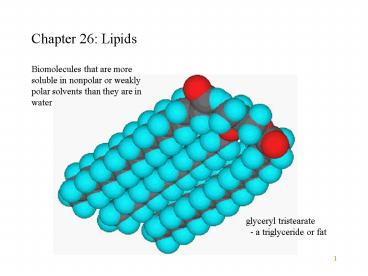Chapter 26: Lipids - PowerPoint PPT Presentation
1 / 33
Title:
Chapter 26: Lipids
Description:
Fat-soluble Vitamins. found in carrots and some. yellow and ... Fat-soluble Vitamins. 32. occurs in fish oil and some. vegetable ... soluble vitamins with it ... – PowerPoint PPT presentation
Number of Views:180
Avg rating:3.0/5.0
Title: Chapter 26: Lipids
1
Chapter 26 Lipids
Biomolecules that are more soluble in nonpolar or
weakly polar solvents than they are in water
glyceryl tristearate - a triglyceride or fat
2
- Acetyl Coenzyme A
- Fats, Oils, and Fatty Acids
- Phospholipids
- Waxes
- Prostaglandins
- Terpenes and the Isoprene Rule
- Isoprene units and terpenes
- Isopentenyl pyrophosphate
- Carbon-carbon bond formation in terpene
biosynthesis - Steroids
- Cholesterol
- Vitamin D
- Bile acids
- Corticosteroids
- Sex hormones
- Carotenoids
- Fat-soluble Vitamins
3
- Acetyl Coenzyme A
4
- Acetyl Coenzyme A
5
- Fats, Oils, and Fatty Acids
glycerine (glycerol)
- a triglyceride
- animal fat
- Rs more saturated
- higher melting point
- (solid at RT)
- vegetable oil
- Rs more unsaturated
- lower melting point
- (liquid at RT)
fatty acids
6
- Fats, Oils, and Fatty Acids
- fatty acids
- most have even numbered chains, between 12 and 20
carbons - cis isomer predominates in unsaturated fatty
acids - more unsaturation ? lower melting point
stearic acid (180) m.p. 70ºC oleic acid
(9-181) an ?-9 fatty acid m.p. 16ºC linoleic
acid (9,12-182) an ?-6 fatty acid m.p.
-5ºC linolenic acid (9,12,15-183) an ?-3 fatty
acid m.p. -11ºC
7
- Fats, Oils, and Fatty Acids
- stearic acid
- packs better intocrystal lattice
- m.p. 70ºC
- oleic acid
- m.p. 16ºC
- linoleic acid
- packs least well intocrystal lattice
- m.p. -5ºC
8
- Fats, Oils, and Fatty Acids
9
- Fats, Oils, and Fatty Acids
10
- Fats, Oils, and Fatty Acids
- Fatty acid biosynthesis
11
- Fats, Oils, and Fatty Acids
- Triglyceride biosynthesis
12
- Phospholipids
phosphoric acid esters
hydrophilic head group
glycerol
carboxylic acid esters
- along with proteins, are major constituent of
cell membranes in plants and animals
hydrophobic tail - consists mostly of palmitic
(160) stearic (180) and oleic (181) acids
13
- Phospholipids
Cell membranes
proteins
lipid bilayer
cholesterol
phospholipid
14
- Waxes
15
- Prostaglandins
- originally isolated from semen and thought to be
produced only in the prostate gland - now known to be present in almost all animal
tissues - functions
- smooth muscle contraction
- inhibition of platelet aggregation
- lowering of blood pressure
- induction of labor
- all based on the prostanoic acid structure
16
- Prostaglandins
- synthesized in the body from 20-carbon
polyunsaturated fatty acids
17
- Prostaglandins
- stimulates contraction of uterine muscle
- used as an abortifacient
- but very rapidly degraded in the body
- the synthetic prostaglandinCarboprost is 10 to
20 timesmore potent, and also degradesmuch more
slowly in the body
18
- Terpenes and the Isoprene Rule
- Isoprene units and terpenes
- terpenes
- volatile components of essential oils
- made up of isoprene units, usually joined
head-to-tail
myrcene (bayberry oil)
farnesol (musk mallow)
19
- Terpenes and the Isoprene Rule
- Isoprene units and terpenes
Classification of terpenes Class Number of
isoprene units monoterpene 2 sesquiterpene 3 diter
pene 4 sesterpene 5 triterpene 6 tetraterpene 8
20
- Terpenes and the Isoprene Rule
- Isoprene units and terpenes
21
- Terpenes and the Isoprene Rule
- Isopentenyl pyrophosphate
22
- Terpenes and the Isoprene Rule
- Carbon-carbon bond formation in terpene
biosynthesis
23
- Steroids
- Cholesterol, hormones, bile acids
- all have this tetracyclic ring structure
- most have methyl groups at C-10 and C-13
- most steroids have all-trans ring fusions
- groups at the points of ring fusion are axial
(anti) - as a result the ring system is nearly flat and
quite rigid
24
- Steroids
- Cholesterol
- precursor to other hormones
- essential component of biological membranes (140
g in healthy adult) - transported in the blood as a soluble complex
with lipoproteins - low-density lipoproteins (LDL) can be deposited
in blood vessels - high-density lipoproteins (HDL) minimize deposits
25
- Steroids
- Vitamin D
vitamin D3 is involved in the regulation of
calcium and phosphorus metabolism - essential
for preventing rickets
26
- Steroids
- Bile acids
- produced in the liver, stored in the gall
bladder, secreted into the intestine - anions at bile and intestinal pH
- help to emulsify dietary fats and aid in their
digestion
27
- Steroids
- Corticosteroids
- produced in the adrenal cortex
- control electrolyte balance, regulate metabolism
of carbohydrates, decrease inflammation, involved
in reaction to stress, allergic response
28
- Steroids
- Sex hormones
- androgens (male sex hormones)
- produced in the testes
- responsible for development of male sex
characteristicsestrogens (female sex
hormones) - produced in the ovaries
- responsible for development of female sex
characteristics - progesterone suppresses ovulation
- synthetic substances such as 17-ethynylestradiol
are more potent at suppressing ovulation - important as oral contraceptives
29
- Carotenoids
- natural pigments characterized by tail-to-tail
linkage between two 20-carbon units - absorb light in the visible portion of the
spectrum due to the extended conjugation - therefore colored
30
- Fat-soluble Vitamins
found in carrots and someyellow and green
vegetables
found in fish-liver oils and dairy products
31
- Fat-soluble Vitamins
32
- Fat-soluble Vitamins
- occurs in fish oil and some vegetable oils, and
in leafy green vegetables - functions as an antioxidant - traps peroxy
radicals (ROO) formed during enzyme-
catalyzed oxidation
- essential for blood clotting
33
- Fat-soluble Vitamins
- Passes through GI tract untouched
- carries some fat-soluble vitamins with it
- products containing Olestra usually have higher
levels of fat-soluble vitamins added to them to
make up for this loss































